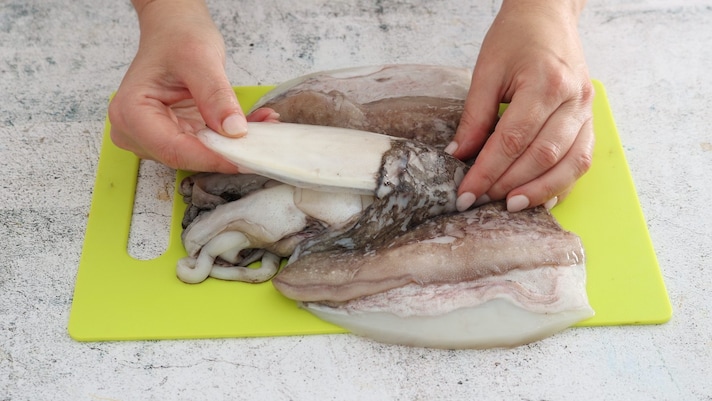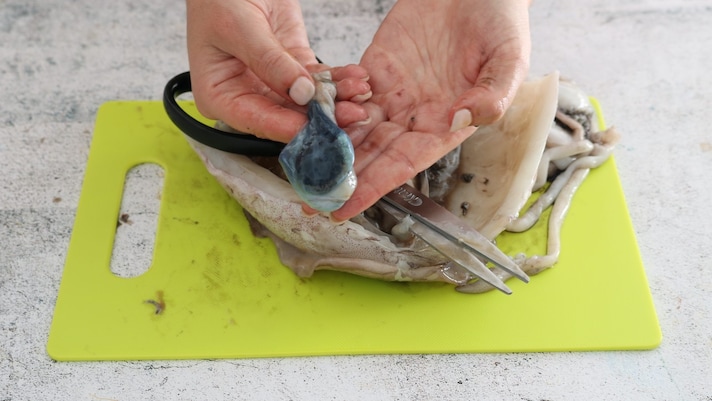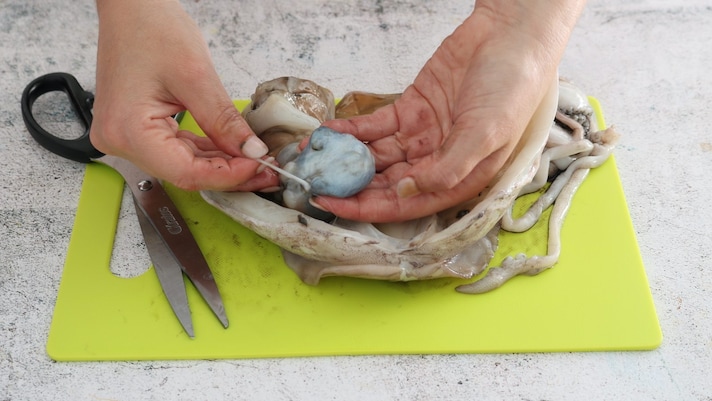
Trying to clean cuttlefish may seem, at first glance, a complicated and uninviting operation: between ink, skin to remove and innards to manage, many prefer to delegate the task to the fishmonger or choose ready-made products. Yet, with a little care and a little practice, cleaning cuttlefish can become a simple and quick gesture, capable of restoring all the authentic flavor of this prized mollusc. Here is a small guide that will teach you everything about cleaning cuttlefish: here is how to proceed step by step, with practical advice and little tricks to save time, avoid waste and bring delicious and inviting recipes with cuttlefish to the table.
How to Clean Cuttlefish
First, if possible, wear latex gloves to protect your hands from ink and lingering odors: prepare a cutting board, a sharp knife and/or scissors, a bowl to collect the scraps. Position yourself near the sink.
Locate the cartilaginous bone (gladius) by pressing lightly on the back of the cuttlefish: make an incision and remove it delicately.

Inside the abdominal cavity, look for the ink sac, recognizable by its dark color: remove it carefully to avoid breakages and store it in a humid bowl if you want to use it in cooking.

Grasp the head and gently pull it away from the body, simultaneously removing the innards. Remove the "beak" (rostrum) located in the center of the tentacles by pressing with your fingers. Remove the eyes by making a circular incision around each one.

Slightly cut the outer skin and remove it with your hands to obtain a more tender and uniform meat during cooking. Wash both the body and the head thoroughly under running water to eliminate any residue.
Tips And Tricks to Clean Cuttlefish Easily
Not everyone is used to cleaning fish products, especially molluscs and crustaceans that have cavities and particular bones: if you prefer to save time, many fishmongers offer a cuttlefish cleaning service on request. Otherwise, try following our advice that will allow you to speed up and make cleaning easier.
- If you think you are not good at cleaning them, you can use partially frozen cuttlefish: in this way, the skin is easier to remove and the ink is less likely to come out. Alternatively, you can also just cool them: put them in the fridge for 15-20 minutes, without freezing them completely.
- Use scissors, which allow you to make clean and precise cuts, especially to cut the tentacles, the eyes, the beak but also to open the sac.
- Work under running water: Holding the cuttlefish partially under a thin stream of running water can prevent the ink from spreading everywhere. Don't overdo the stream, or you'll break the sac.
- Use coarse salt to help remove the skin: Gently rubbing the surface of the cuttlefish with a little coarse salt can help the skin adhere better to your fingers and make it easier to remove, especially with larger cuttlefish.
- Keep your ink bag moist: If you want to save your ink for cooking, place the bag in a bowl with a damp cloth and store it in the refrigerator.
- Clean them all immediately and keep them ready. If you have more cuttlefish to work with, it is better to clean them all at once, then keep them already cleaned in the fridge (up to 24 hours) or in the freezer.

How to Tell When Cuttlefish is Fresh
Understanding whether a cuttlefish is fresh is essential to ensure a good outcome in the kitchen, both in terms of taste and food safety. When you are at the fish counter, there are some precise signs to look for to distinguish a fresh product from one that is better left there.
1. Bright and Full Eyes
The eyes of the cuttlefish must be bright, protruding and transparent. If they are opaque, dull or sunken, it is a clear sign that the mollusc is not fresh.
2. Fresh, Sea-Like Smell
The aroma should be reminiscent of sea water, fresh and delicate: any strong, pungent or ammonia-like scent is an indication of poor freshness.
3. Tight and Slightly Slimy Skin
The surface of the cuttlefish must be shiny, compact and with a slight slippery patina: if it is too dry, sticky or excessively slimy, it is better not to buy it.
4. Bright and Uniform Color
The color can vary from grey to dark beige, but must be bright and uniform: the presence of yellowish halos or opaque stains may indicate that the product is old.
5. Firm and Elastic Body
Consistency is another important indicator: a fresh cuttlefish should be firm to the touch, not soft or flaccid. If it easily gives way to pressure, it is probably not from the day.
6. Absence of Liquids
Fresh fish does not release much liquid: if you see a pool of dark or milky liquid in the tray or in the refrigerated display case, it is likely that the cuttlefish is defrosted or no longer fresh.
7. Beware of Thawed Cuttlefish
Many retailers offer defrosted cuttlefish, which are not necessarily to be avoided, but must be declared by law. If you intend to consume them raw or preserve them for a longer time, it is important to know this. Some signs that may indicate a defrosted cuttlefish: slightly dull color, softer and less elastic tissue, presence of water in the container or on the bottom of the tray.
;Resize,width=767;)
